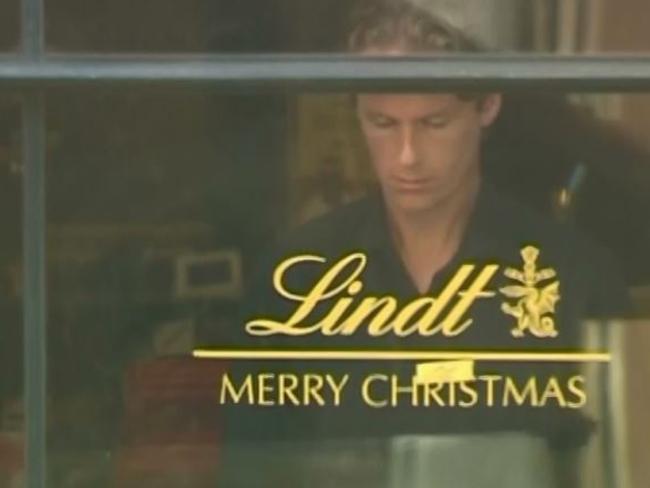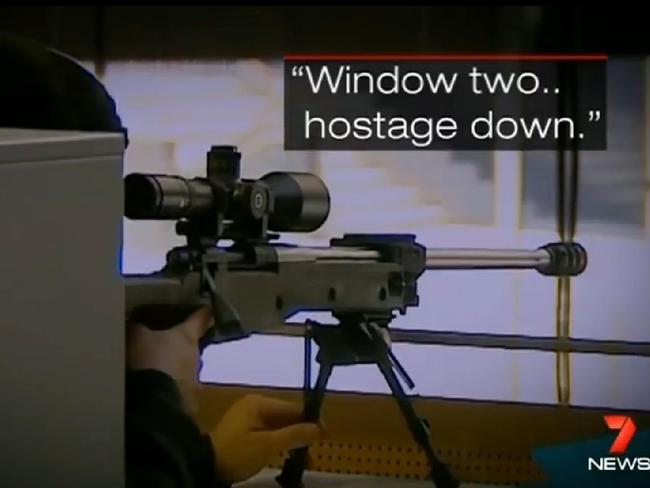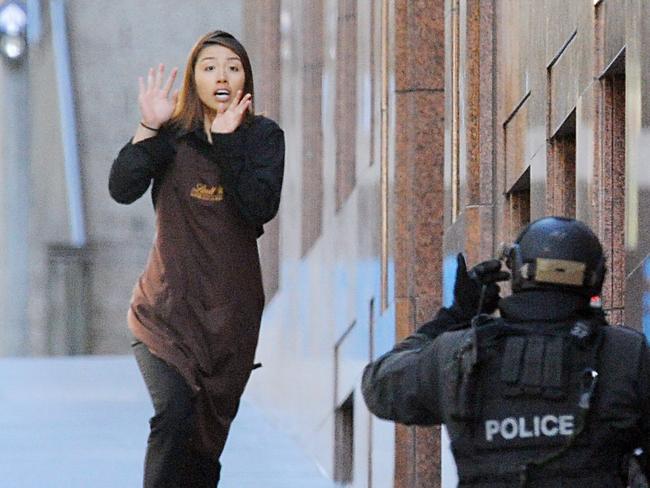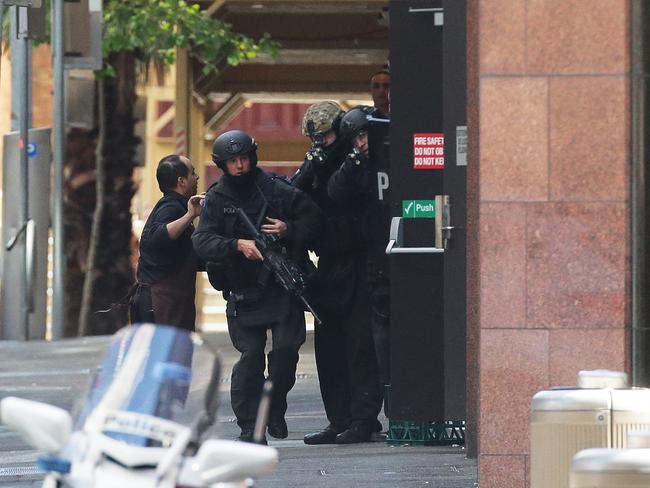Lindt Cafe siege inquest: Sniper tells of watching hostage Tori Johnson die
A LINDT Café siege sniper has told of the moment he saw hostage Tori Johnson executed and revealed why he didn’t take a shot.
A LINDT Café siege sniper has told of the moment he saw hostage Tori Johnson executed and revealed why he didn’t take a shot at gunman Man Haron Monis earlier in the day.
The senior constable, who can only be identified as Sierra 3-3, was one of several marksmen located in three vantage points throughout Martin Place during the 17 hour ordeal which ended with two hostages dead.
He today told the inquest that in the final moments of the siege he looked through “window two and (his) focus was drawn on who (he) thought was Tori”.
“It appeared to me that he had taken a lower profile because I could only see him from his waist up which made me think he was on his knees,” he said.
“I recall seeing that and commentating what I was seeing.
“(I said) words to the effect of ‘I think he’s on his knees, I think he’s on his knees’.”
Sierra 3-3 said Mr Johnson was facing towards Phillip St. He heard his call broadcast over the police radio but didn’t hear a response.
Counsel assisting Sophie Callan asked if he deemed the sight of Mr Johnson on his knees “a significant matter” at the time.
“I thought it was odd. I hadn’t seen anyone else in that position throughout the day,” he said.
“I didn’t form a view there was imminent risk or threat to (Mr Johnson) only because I couldn’t see where Monis was.”
At 2.13am on December 16, 2014, Monis shot Lindt Café manager Mr Johnson dead at point blank range.

“I saw what I thought was a muzzle flash. And then I saw Johnson fall forward,” Sierra 3-3 said.
Ms Callan: “Did you observe him resume his kneeling position?”
Sierra 3-3: “I couldn’t see him after that.”
“I said ‘white window 2, hostage down’. I said that twice and again I heard that being broadcast over the radio.”
Ms Callan: “Why did you repeat what you saw?”
Sierra 3-3: “I just wanted to reiterate what I did see and make it known.”
An emergency action plan was then initiated, prompting tactical operations officers to storm the cafe and kill Monis. Barrister Katrina Dawson was killed by a fragment of a police bullet in the crossfire.
Sierra 3-3 said it seemed only 30 seconds to one minute passed between the moment he noticed Mr Johnson on his knees and saw him murdered.
Earlier, he told the inquest he didn’t get the opportunity to take down the gunman prior to any hostages being killed.
Sierra 3-3 and 3-2 were positioned in the best vantage point, on level one, inside the Westpac building from about 10.30am on December 15, 2014. Other snipers were deployed to the Channel 7 and RBA buildings.
Sierra 3-3, said it wasn’t until around 5.30pm that he had his first clear view of Monis but that he didn’t feel “100 per cent” justified in pulling the trigger.

“He was stationary…You could see a small portion of what I believed to be his head, from the cheek upwards. I could see the black headband which is what made me think it was him. There was a hostage in there holding up an apron, or something, obscuring most of that window,” Sierra 3-3 said.
“I relayed that, ‘I think that’s him’, and (that was) relayed … over the radio. The discussion (between snipers) was ‘we think that’s him because of the headband, it looks like him from the photos that we’ve seen’.”
It had been about eight hours since the gunman, proclaiming to be a member of ISIS, had first taken 18 people hostage. Several hostages had escaped and the stronghold was relatively calm at that point.
Sierra 3-3 said he was not confident he could hit the target without risk to the remaining hostages and that was ultimately why he didn’t fire.
“At the end of the day it wasn’t an option both for justification reasons and ... not knowing what was behind him,” he told the inquest.
“I was quietly confident it was him but not 100 per cent. He wasn’t posing a threat to anyone at that time.
“I simply couldn’t see what he was doing enough to make a decision. When he walked past those windows I saw a silhouette of what I thought was a firearm. (I was looking for) an imminent life threatening situation.”

In daylight, Sierra 33 could see about 5-6m into the Lindt Café windows.
“That’s excluding shadows cast at the rear of the building to the ‘black’ side,” he said.
At night, Sierra 33 could see about 4-5m into the cafe through the windows.
“Anything beyond that was pretty hazy,” he said.
Ms Callan asked Sierra 3-3 what the consequences would have been if snipers fired at the target and missed.
Sierra 3-3 said it would have compromised the snipers’ position and intentions.
“I’m not sure what that would do within the stronghold, how (the gunman) would react to that,” he said.
“Potentially it would (have been) catastrophic.
“I can’t speak for what (Monis) would do but can only envisage that would force his hand into taking matters into his own hands. (It would have increased the) threat of potential injury to hostages ...by me… the rounds I was using were of such a nature designed to penetrate hard mediums…and I’ve got no doubt it would have penetrated the target and kept going and ricocheting.”
Sierra 3-3 told the inquest how the plan was for Sierra 3-2 to fire a breach shot to form a “tennis ball sized” hole in the glass of the Westpac window so he could immediately follow through with a shot at the target if the opportunity arose.
The aim would have been to strike Monis in the head and cause “flaccid paralysis” or immediate death.
Ms Callan quizzed Sierra 3-3 on what the snipers would have been “trying to achieve” by aiming for the head of the target.
“Kill,” Sierra 3-3 said.

“For the body to instantly go numb. No jerking or reactions once that round’s hit.”
Ms Callan: “Did you discuss with your Sierra 3 colleagues the view you had on the night?”
Sierra 33: “Yes. We had a plan in place for if it was deemed necessary we had to act immediately. The discussion was it’s not an ideal situation we’re in given all those considerations we have to take in to (fire) the shot. However if there is imminent or life threatening situations occurring we would attempt to act. As acting is better than doing nothing.”
Sierra 3-3 stayed in position all day, only moving away for toilet breaks, and when going deeper into the room briefly when the sun obstructed their view.
But according to Sierra 3-3, the opportunity to act simply didn’t arise.
Ms Callan: “With everything taken into account, did you form a view on the night of the viability of taking a shot?”
Sierra 3-3: “It wasn’t great. Having two mediums of glass to get through (it was a) potential hazard that would cause if the shot was missed, the risk to those inside. All of those things greatly reduced our confidence.”
“I would have to be satisfied I would be justified in taking a shot. That would be if there was imminent threat to a member of the public…hostages. I only act on my own assessment…I’m no more justified in firing my firearm than a general duties officer on the street.”
The inquest has previously heard that Monis fired his first shots toward six hostages as they fled the building at 2.03am. Moments later, Mr Johnson was ordered to his knees. At 2.09am Monis fired another shot into the ceiling. Mr Johnson remained on his knees for about another four minutes until he was executed at 2.13am.
Counsel for Tori Johnson’s family, Gabrielle Bashir, SC:
“I suggest to you a hostage being viewed on their knees, a shot being fired in the stronghold and knowing that a hostage taker professed allegiance to Islamic State couldn’t have been anything other than an imminent risk to (Mr Johnson).”
Sierra 3-3: “At no time could I see anyone posing an imminent threat to him.”
Ms Bashir: “Even though Monis had just fired a shotgun and potentially had a (bomb) strapped to him…”
Sierra 3-3: “I could not see Monis.”
Sierra 3-3 was asked if “anything could have been done more effectively by (the) Sierra team that night”.
“I think we were pretty limited in what we could have done,” he said.
“I think we did the best we could on the day.”
The inquest continues.

